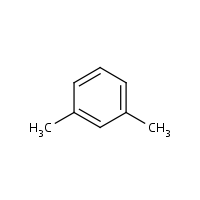m-Xylene
Agent Name
m-Xylene
Alternative Name
1,3-Dimethylbenzene
CAS Number
108-38-3
Formula
C8-H10
Major Category
Solvents

Synonyms
1,3-Dimethylbenzene; 1,3-Xylene; Benzene, 1,3-dimethyl-; m-Dimethylbenzene; m-Methyltoluene; m-Xylol; Benzene, m-dimethyl-; Xylene, m-; [ChemIDplus] meta-Xylene; [ICSC] 3-Xylene; m-Methyltoluene; [HSDB] UN1307
Category
Aromatic Solvents
Description
Colorless liquid; [Merck Index] Sweet odor; [CHRIS]
Sources/Uses
Permitted for use as an inert ingredient in non-food pesticide products; [EPA] Found in coal tar; Commercial xylene is a mixture of the o-, m-, and p- isomers with the m-isomer predominating; Used as a solvent, to make dyes, and to sterilize catgut; [Merck Index] Used as a solvent and to make polyester and alkyd resins, insecticides, aviation fuel, and dyes; [HSDB]
Comments
A skin and eye irritant; May have CNS effects; An aspiration hazard by ingestion; May have adverse effects on human reproduction or development, based on animal studies; [ICSC] May cause smarting and reddening of skin if spilled and allowed to remain on clothes; High vapor concentrations may cause mild smarting of eyes and respiratory system; May cause liver and kidney injury; [CHRIS] A local irritant; Inhalation of high concentrations may cause narcotic effects, severe coughing, and pulmonary edema; Ingestion may cause kidney and liver injury; [NTP] A skin and strong eye irritant; Harmful by inhalation and skin absorption; May cause narcosis, lung irritation, chest pain, pulmonary edema, CNS depression, blood disorders, liver and kidney injury, and reproductive disorders; [Sigma-Aldrich MSDS] See "Xylene isomers."
Biomedical References
Exposure Assessment
BEI
Xylenes (technical or commercial grades): 0.3 g/g creatine methylhippuric acids in urine at end of shift; [ACGIH TLVs and BEIs]
Skin Designation (ACGIH)
No
TLV (ACGIH)
100 ppm
STEL (ACGIH)
150 ppm
PEL (OSHA)
100 ppm
MAK
100 ppm
IDLH (NIOSH)
900 ppm
Vapor Pressure
8.29 mm Hg
Odor Threshold Low
0.05 ppm
Lethal Concentration
LC50 (rat) = 5,984 ppm/6hr
Explanatory Notes
Odor threshold from CHRIS; The Guide in the Emergency Response Guidebook is for "Xylenes." VP from ChemIDplus;
NFPA
may ignite at ambient temp
Adverse Effects
Neurotoxin
Acute solvent syndrome
Hepatotoxin
Hepatoxic (a) from occupational exposure (secondary effect) or (b) in animal studies or in humans after ingestion
IARC Carcinogen
Not classifiable
ACGIH Carcinogen
Not Classifiable
Diseases, Processes, and Activities Linked to This Agent
Diseases
Occupational diseases associated with exposure to this agent:
Processes
Industrial Processes with risk of exposure: